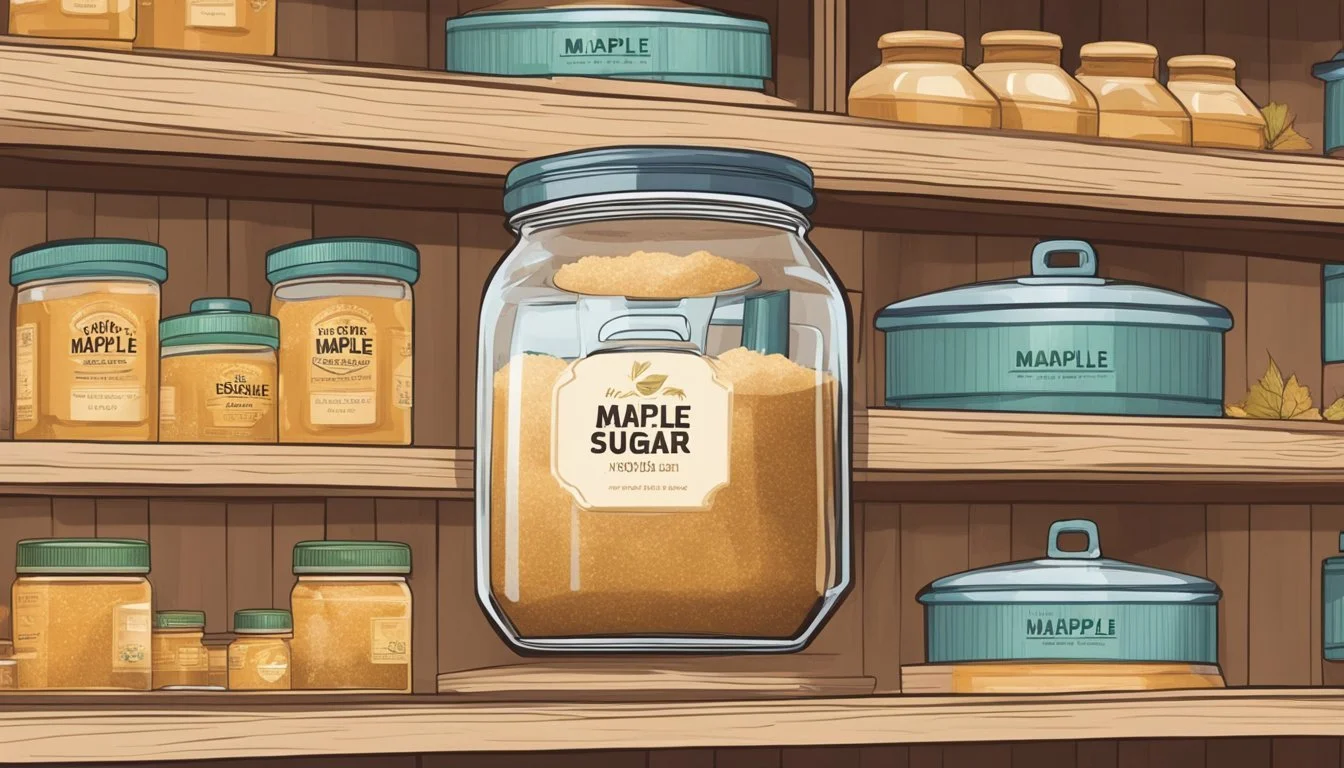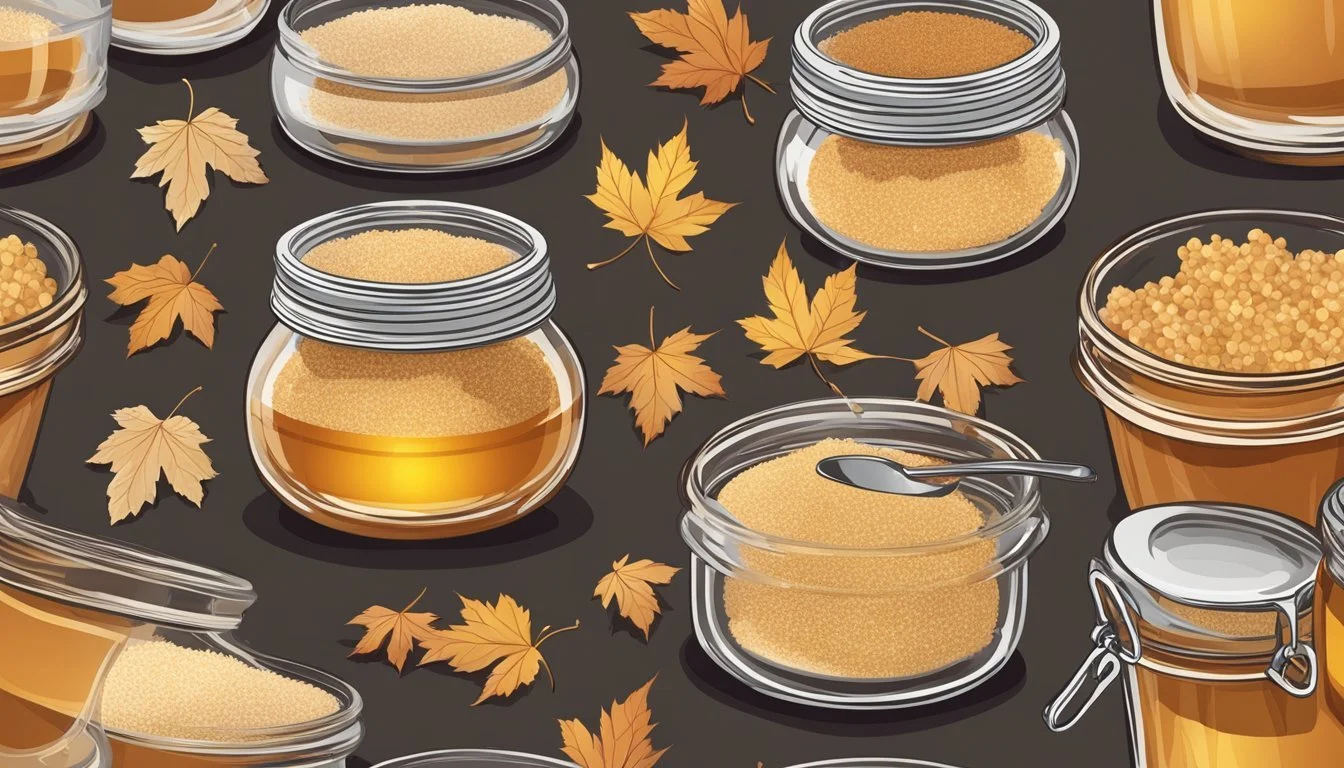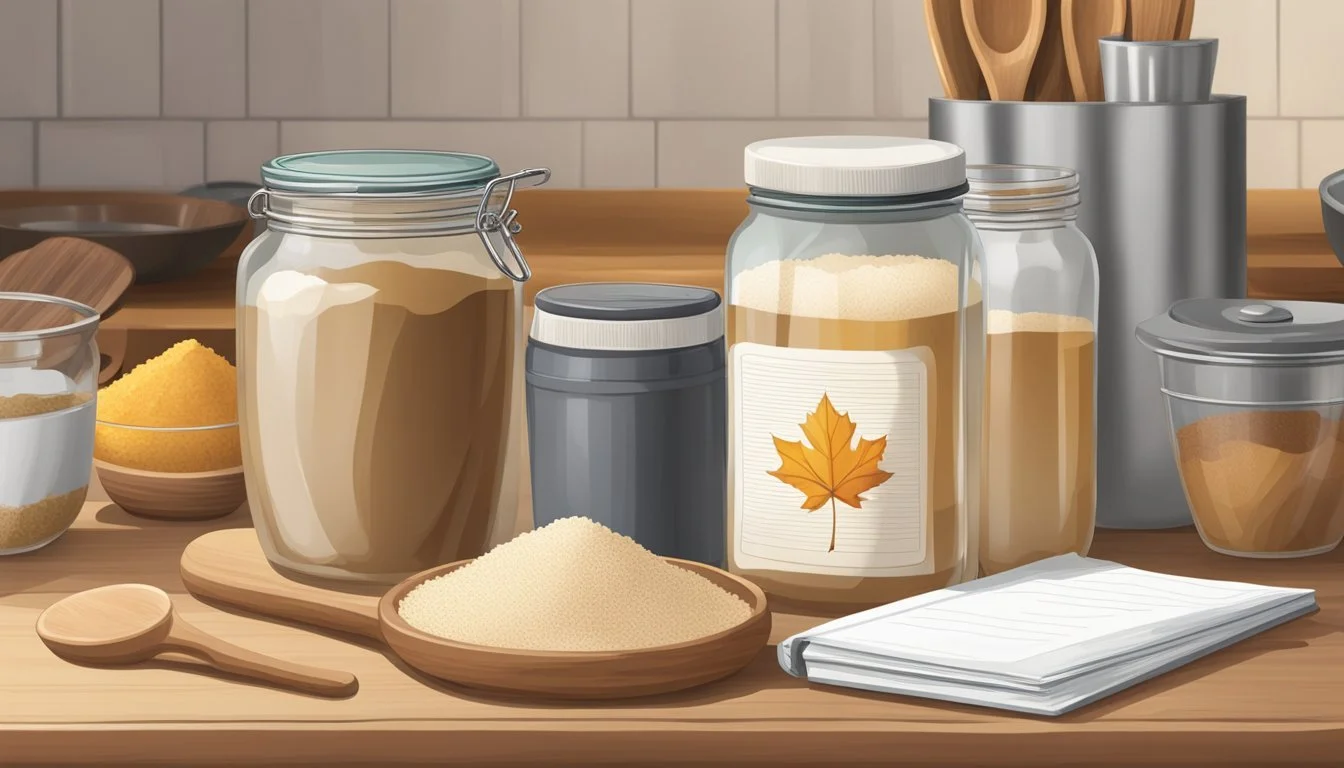Does Maple Sugar Go Bad?
Shelf Life and Storage Tips
Maple sugar, a delightful natural sweetener derived from sugar maple trees, is cherished for its unique flavor and versatility. As with many natural products, there's a common question: Yes, maple sugar can go bad. Proper storage and handling are crucial to extending its shelf life.
Over time, maple sugar can lose its quality and develop off-flavors or become hard. Factors such as exposure to moisture and air can accelerate this process. Airtight containers and cool, dry places are recommended to keep maple sugar in optimal condition.
Understanding the signs of spoilage, like changes in texture, color, and smell, can help you ensure that your maple sugar remains safe and delicious. Knowing these tips can help you make the most of this natural sweetener.
Composition and Types of Maple Sugar
Maple Sugar Composition
Maple sugar is created by boiling down pure maple syrup until it crystallizes. The primary ingredient is sucrose, which is present in high amounts due to the concentration process. It also contains glucose and fructose in smaller quantities.
Apart from sugars, maple sugar includes minerals like manganese, iron, zinc, and copper. These elements come from the natural sap of maple trees.
Grades of Maple Sugar
Maple sugar can be differentiated based on the grade of the maple syrup used:
Grade A: Light and delicate flavor, often used for table sugar replacements.
Grade B: Darker with a robust flavor, ideal for recipes requiring a strong maple presence.
The grade impacts both the taste and color of the final product.
Types of Maple Sugar
Maple sugar can be found in various forms:
Granulated Maple Sugar: The most common type, similar to regular granulated sugar.
Maple Sugar Blocks: Pressed into solid blocks for easy storage and shaving as needed.
Maple Sugar Crystals: Coarse, raw form, often used as a topping for desserts.
Production Process
The journey from sap to maple sugar begins with extracting sap from maple trees. The sap is then boiled to create a concentrate. Further heating and stirring result in the crystallization, producing maple sugar.
Thanks to its natural origins and minimal processing, maple sugar retains many of the nutrients found in maple sap.
Shelf Life and Spoilage Indicators
When discerning the shelf life and spoilage indicators of maple sugar and syrup, it's vital to know how storage conditions affect their longevity. This section addresses various states: unopened, opened, and signs of spoilage to watch out for.
Unopened Maple Syrup
Unopened maple syrup has an extremely long shelf life. When stored properly in a cool, dark place, this sweetener remains stable for years. The Massachusetts Maple Producers Association states that unopened maple syrup can keep indefinitely. It's critical to maintain the integrity of its seal to ensure longevity.
Opened Maple Syrup
Once opened, maple syrup requires refrigeration. Keeping opened syrup cold helps preserve its flavor and prevents microbial growth. Typically, refrigerated syrup remains in good condition for about one year. Refrigeration inhibits spoilage and maintains the product's consistency and taste over time.
Signs of Spoilage
Spoilage in maple syrup manifests in several forms. Common signs include mold formation, changes in smell, and alterations in color or taste. If any mold appears, it's generally safe to remove by boiling and skimming the surface. Off-smell or unusual flavor suggests the syrup has likely gone bad. Consistency changes can also indicate spoilage, necessitating careful evaluation before consumption.
Proper Storage Practices
The longevity of maple sugar and syrup is greatly enhanced by proper storage techniques. Key practices involve keeping them away from moisture and ensuring they are in suitable containers.
At Room Temperature
Maple sugar can be stored at room temperature if kept in a cool, dark place. When storing maple sugar, always use a dry and clean container. Glass containers with tight-fitting lids are ideal for this purpose, but plastic containers can also be used as long as they seal well and do not allow moisture in. Avoid storing sugar near heat sources or in areas with high humidity, as moisture can cause the sugar to harden and lose its quality.
Refrigeration Techniques
For maple syrup, after opening, refrigeration is crucial to prolong its shelf life. Transfer the syrup to a clean container if it is not already in one. Glass or plastic containers with airtight lids work best. This step helps maintain the flavor and prevents spoilage. The typical refrigerated shelf life of opened maple syrup is about one year. Ensure to keep the refrigerator at a consistent, cool temperature, as fluctuations can affect the syrup's quality.
Freezing Maple Syrup
Freezing maple syrup is an excellent method for long term storage. Use freezer-safe glass or plastic containers and avoid filling them to the brim to allow for expansion. Frozen syrup can last for several years without a significant loss in quality. To use frozen syrup, simply thaw it in the refrigerator or at room temperature. Avoid repeatedly thawing and refreezing, as this can degrade the syrup’s quality.
By following these storage tips, one can enjoy the sweetness of maple products for extended periods. Proper container choices and storage environments are key to maintaining quality.
Impacts of Improper Storage
Improper storage of maple sugar can lead to contamination, changes in texture, and consistency issues. Proper storage methods are essential to preserving the quality and usability of the product.
Contamination and Microorganisms
Improper storage can expose maple sugar to contaminants and microorganisms. Moist environments can encourage mold growth, making the sugar unsafe to consume. Keeping the sugar in a dry and airtight container is paramount to prevent contamination. When stored in humid conditions, sediment may form, leading to potential spoilage. Discarding moldy or discolored sugar ensures safety and maintains quality. Ensuring that the storage containers are moisture-proof helps in avoiding contamination and microorganism growth.
Texture and Consistency Changes
Incorrect storage can significantly impact the texture and consistency of maple sugar. Humidity can cause the sugar to clump together, forming crystals and making it hard to use in recipes. This clumping can eventually lead to the sugar becoming hard and difficult to measure. To maintain a fine texture, it is recommended to store maple sugar in airtight and opaque containers. Freezing maple sugar, if properly sealed, can also help in preserving its consistency over time. Crystals forming in improperly sealed containers indicate compromised quality, and effort should be made to store the sugar appropriately to avoid such issues.
Maple Sugar as an Ingredient
Maple sugar is a versatile ingredient that can be used in many culinary contexts, imparting a unique and rich flavor. It is particularly valued in both everyday and gourmet recipes for its distinct characteristics.
Cooking and Baking
Maple sugar can be used in a wide array of recipes, including those for pancakes and waffles. Its flavor is more complex than regular sugar, adding depth to dishes. With its ability to caramelize well, it is ideal for baked goods such as cookies, cakes, and muffins.
A tablespoon of maple sugar can be a direct substitute for brown sugar in recipes. When used in marinades and glazes, it imparts a subtle sweetness and a hint of smokiness that elevates the dish's profile.
Adding maple sugar to oatmeal or granola enhances its natural sweetness, making it a desirable ingredient for breakfast dishes. Even savory recipes, such as roasted vegetables or meats, benefit from the distinctive flavor of this natural sweetener.
Syrups and Sweeteners
While maple syrup is a popular choice for topping pancakes and waffles, maple sugar provides a concentrated alternative that can be transformed into syrups by dissolving it in water. This method allows for customization of syrup thickness and sweetness.
Maple sugar can serve as a substitute for other sweeteners like honey, corn syrup, or molasses in recipes. This makes it a flexible ingredient for those seeking alternatives with a unique flavor.
Particularly in holiday recipes, maple sugar can be used to create rich, flavorful desserts and confections. Its use in frostings and fillings adds a delightful complexity that is hard to achieve with conventional sweeteners.
By understanding the versatility of maple sugar, cooks and bakers can expand their culinary repertoire and create dishes that stand out with their distinctive taste.
Understanding Grades and Labels
Real maple syrup is available in various grades that reflect its color and flavor. These grades help consumers choose the right syrup for their tastes and uses.
Grade A Golden Color, Delicate Taste:
This grade features a light color and mild, delicate flavor. It's perfect for those who prefer a subtle maple taste. High in sugar content, it is ideal for drizzling over pancakes or waffles.
Grade A Amber Color, Rich Taste:
This more robust syrup has an amber hue and a richer flavor than the Golden variety. It is commonly used and works well in many dishes, from breakfast foods to marinades.
Grade A Dark Color, Robust Taste:
With a dark color and bold flavor, this grade is designed for those who love a strong maple presence. It's excellent in baking and cooking, where its robust taste can shine through.
Grade A Very Dark Color, Strong Taste:
This grade has the deepest color and the most intense flavor, resembling molasses or brown sugar. It is often used as a natural sweetener in recipes that benefit from a strong maple flavor.
Here’s a simple table to summarize the grades:
Grade Color Flavor Ideal Uses Grade A Golden Light Mild, delicate Pancakes, waffles Grade A Amber Amber Rich Breakfast foods, marinades Grade A Dark Dark Robust Baking, cooking Grade A Very Dark Very Dark Intense, strong Strong-flavored recipes, sweeteners
The Vermont Maple Sugar Makers’ Association maintains strict standards to ensure the quality and consistency of maple syrup produced in Vermont, known for its high-quality syrup.
These grades and labels make it easier for consumers to select the perfect maple syrup for their needs.
Frequently Asked Questions
Maple syrup is a delicious treat, but knowing when it has gone bad and how to handle it properly is crucial. Below are answers to some common questions on these topics.
How to Tell If Maple Syrup Is Bad?
Detecting spoiled maple syrup involves looking for specific signs. Odor changes are a telling indicator; a deviation from the typical sweet smell could mean spoilage. Taste alteration is also crucial. A sour or off taste can signal that the syrup has absorbed other flavors or contaminants. Visual signs like mold can also appear.
Storage guidelines are essential for maintaining syrup quality. Unopened maple syrup maintains its best quality for up to a year in the pantry but can last indefinitely when frozen. Once opened, it should be kept refrigerated and lasts up to a year.
Can Maple Syrup Be Skimmed and Used?
If mold appears on the maple syrup, it can often be skimmed off. To do this, remove the mold layer carefully. Afterwards, bring the syrup to a brief boil to kill any remaining mold spores. Skimming and boiling usually render the syrup safe for consumption.
Processed maple syrup often contains more preservatives, reducing the risk of spoilage. However, if mold is persistent or if there are other signs of spoilage, such as odor and taste changes, it may be best to discard the syrup.
Regular inspection and proper storage can prolong the syrup’s shelf life, ensuring it remains safe and flavorful.
Conclusion
Maple sugar, a natural sweetener, can spoil if not stored properly.
Proper Storage: To maximize shelf-life, keep maple sugar in an airtight container. Store it in a cool, dry place to prevent moisture from causing clumping or mold growth. Refrain from exposing it to direct sunlight or high temperatures.
Shelf-Life: Maple sugar, when stored correctly, can last for months. Although not indefinite, its longevity surpasses many other natural products. Proper storage significantly extends its usability.
Preservation Tips:
Use airtight containers.
Keep in a dry, cool place.
Avoid storing near strong odors to maintain its pure flavor.
By following these guidelines, you can enjoy the unique taste of maple sugar for an extended period.






